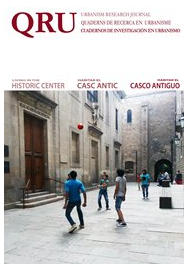Proyectar la residencia en el casco antiguo contemporáneo: los orígenes de la intervención de regeneración en la Ciutat Vella de Barcelona
DOI:
https://doi.org/10.5821/qru.9615Resumen
El reciente proceso de regeneración de Ciutat Vella, materializado entre 1986 y 2004, se fundamenta en un modelo de centro histórico residencial social, fiel al papel que historicamente ha jugado el casco antiguo de Barcelona. Este proceso requirió un consenso institucional y social sin precedentes, y la creación de instrumentos específicos para gestionarlo. Un centro histórico en el que a finales del siglo XX se promocionan más de 3.000 viviendas protegidas y se rehabilitan más de 30.000 viviendas privadas, no es un caso frecuente. Este impulso público está marcado por múltiples experiencias proyectuales que han servido para experimentar soluciones arquitectónicas, han consolidado un modelo de respeto a la trama histórica, y fundamentado en el proyecto urbano integral sobre el espacio público. Este modelo residencial social ha sido útil para normalizar y estabilizar la población y la pirámide de edades. Sin embargo el crecimiento del turismo y de la gentrificación, ponen de relieve el déficit de un patrimonio público de vivienda de alquiler que permita intervenir más activamente en los esfuerzos por mantener, en el futuro, este carácter residencial.Descargas
Número
Sección
Licencia
Aquellos autores/as que tengan publicaciones con esta revista, aceptan los términos siguientes:
Los autores/as conservarán sus derechos de autor y garantizarán a la revista el derecho de primera publicación de su obra, el cuál estará simultáneamente sujeto a la Licencia de reconocimiento de Creative Commons CC BY-NC-ND- 4.0 que permite a terceros compartir la obra siempre que se indique su autor y su primera publicación esta revista, pero no se pueden cambiar ni se pueden utilizar comercialmente.
Los autores/as podrán adoptar otros acuerdos de licencia no exclusiva de distribución de la versión de la obra publicada (p. ej.: depositarla en un archivo telemático institucional o publicarla en un volumen monográfico) siempre que se indique la publicación inicial en esta revista.
Se permite y recomienda a los autores/as difundir su obra a través de Internet (p. ej.: en archivos telemáticos institucionales o en su página web) antes y durante el proceso de envío, lo cual puede producir intercambios interesantes y aumentar las citas de la obra publicada. (Véase El efecto del acceso abierto).













